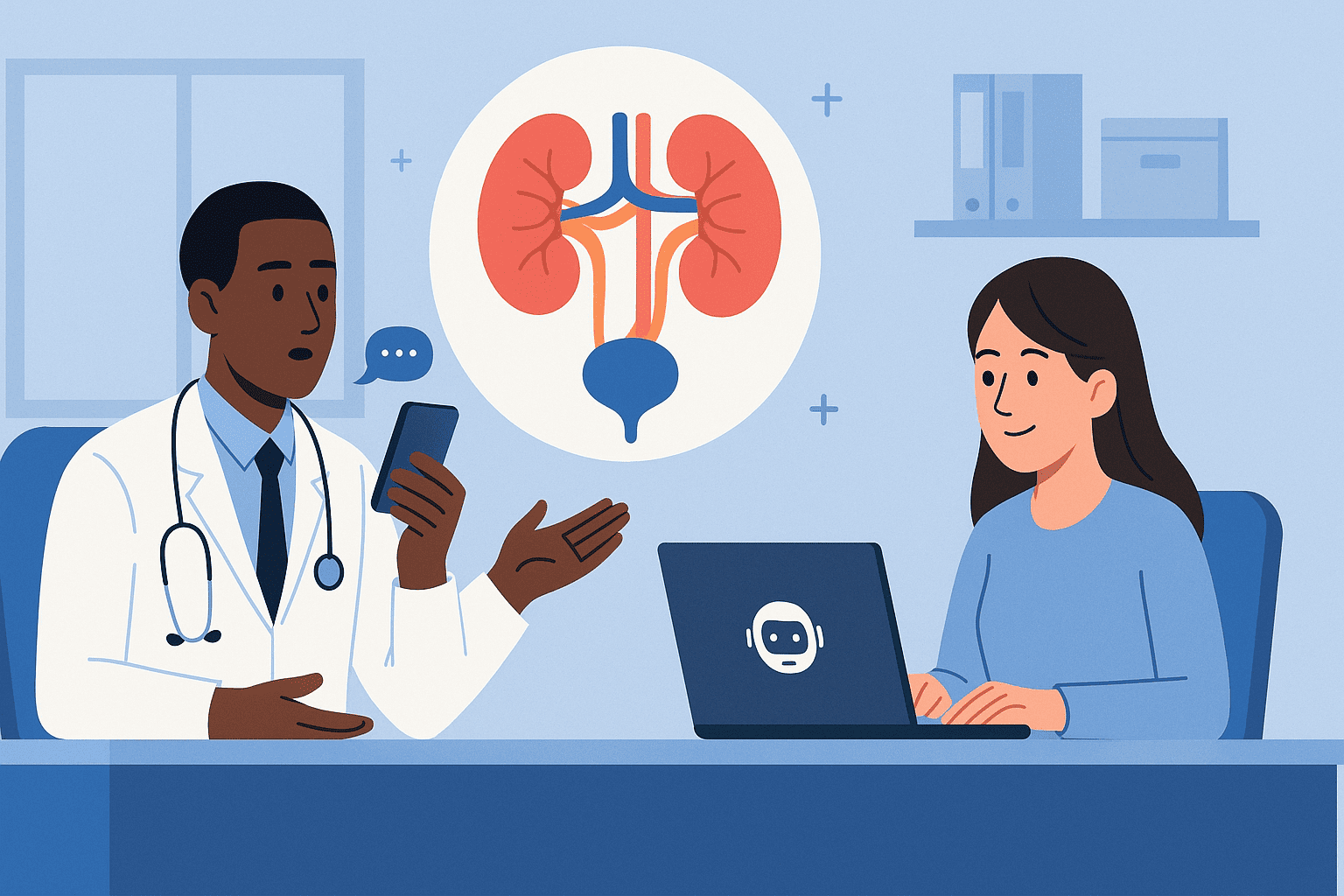Updated on: July 15, 2025
From managing BPH and kidney stones to bladder cancer and robotic prostatectomies, urologists handle a wide range of conditions that demand detailed, precise documentation. But with every procedure, consult, and follow-up comes the burden of note-taking—labs, exams, histories, and surgical findings all need to be recorded.
That’s where DocScrib, the AI-powered medical scribe for urology, comes in. It automates your charting—capturing DREs, uroflow reports, procedural notes, and post-op instructions—in real time.
So whether you’re in the clinic, OR, or rounding post-op, your notes are done before you leave the room.
Why Urology Documentation Is So Demanding
Typical urology notes may include:
-
History and progression of urinary symptoms (e.g., LUTS, hematuria, pain, incontinence)
-
Physical exams like DRE, genital and abdominal findings
-
Test results (PSA, CT KUB, uroflowmetry, cystoscopy, urinalysis)
-
Procedures (cystoscopy, TURP, lithotripsy, biopsy, catheter placement)
-
Surgical consults and follow-ups
-
Oncology and BPH treatment tracking
-
Discussion of sensitive topics (ED, infertility, pelvic pain)
These notes require clinical accuracy, emotional nuance, and coding compliance—making AI support a game-changer.
What Is an AI Medical Scribe for Urology?
An AI scribe for urology like DocScrib listens during patient visits and generates complete, structured notes in real time. It understands urologic terminology—symptoms, test results, anatomical findings, and procedures—and auto-fills documentation so you don’t have to type.
It supports in-person visits, telehealth sessions, and hospital rounds with full HIPAA compliance.
How DocScrib Works in Urology Clinics & ORs
-
Start your session
DocScrib listens securely via mic or device as you interact with the patient. -
Live clinical context extraction
It recognizes DRE findings, stone passage history, uroflow metrics, and more. -
Note generation
Structured SOAP, pre-op, post-op, and procedure notes are created immediately. -
Approve and upload to EMR
Edit if needed and sync directly to your electronic records.
Why Urologists Choose DocScrib
🧪 Captures Genitourinary Symptom Details
LUTS, hematuria, flank pain, retention—all structured in your note.
👨⚕️ Auto-Documents DRE and Physical Exams
Findings like prostate enlargement, nodularity, or testicular masses are inserted accurately.
💻 Summarizes Uroflow and Lab Results
Uroflow patterns, PVR, PSA levels, urinalysis—auto-logged with interpretation.
🔬 Supports Procedure Notes
Templates for cystoscopy, catheterization, biopsy, TURP, stent placement, and more.
💬 Sensitive Issue Documentation
Captures nuanced conversations around ED, incontinence, pelvic floor dysfunction.
🕒 Saves 1–2 Hours Every Day
You focus on care—DocScrib handles the charting.
DocScrib Features Tailored to Urology
-
🧾 Urology-Specific SOAP Templates
For BPH, stones, ED, hematuria, UTIs, infertility, incontinence, and more. -
💉 Procedure & Surgery Templates
Auto-filled notes for cystoscopy, TURP, prostate biopsy, vasectomy, catheter changes. -
🧪 Test Result Integration
PSA trends, CT/MRI reports, uroflow curves, cysto findings—all inserted seamlessly. -
🧠 Longitudinal Care Tracking
Monitor patients over months for cancer, LUTS, chronic prostatitis, and post-op recovery. -
🔐 Fully HIPAA-Compliant
Secure, audit-ready, and customizable per your workflow.
Use Cases in Urology
-
New Consults: BPH, hematuria, incontinence, testicular pain, elevated PSA
-
Procedure Follow-Ups: Stent placement, prostate biopsy, TURP, lithotripsy
-
Oncology Care: Bladder cancer surveillance, prostate cancer tracking
-
Chronic LUTS: Progression of symptoms, IPSS scoring, med titration
-
ED & Infertility Visits: Sensitive issue management, hormonal/lab interpretation
-
Hospital Rounds: Catheter care, post-op TURP/PCNL notes, incontinence assessment
Real-World Example: Urology Associates Group in Texas
📍 4 urologists + 2 PAs using DocScrib across 3 clinics and 2 hospitals
Results in 30 Days:
-
75% reduction in charting time
-
50% faster surgical post-op documentation
-
Improved coding accuracy for cystoscopy and TURP notes
-
More face time with patients and fewer after-hours logins
💬 “I was skeptical at first—but now, DocScrib is like having a full-time scribe who knows exactly what to write for each case. It’s completely changed our documentation game.”
DocScrib vs. Manual Urology Note-Taking
| Feature | Manual Notes | DocScrib AI Scribe |
|---|---|---|
| Uroflow & Lab Result Capture | Manual or pasted | ✅ Auto-structured |
| Procedure & Post-Op Notes | Separate dictation | ✅ Built-in templates |
| DRE + Physical Exams | Variable detail | ✅ Accurate + complete |
| Chronic Symptom Tracking | Inconsistent | ✅ Longitudinal view |
| Sensitive Conversations | Hard to document | ✅ Contextually handled |
| EMR Integration | Time-consuming | ✅ One-click approval |
FAQs: AI Medical Scribes for Urology
Q1. Can DocScrib record uroflow and PSA results?
Yes—DocScrib automatically logs uroflow patterns, voided volume, Qmax, PSA levels, and urinalysis with interpretation.
Q2. Will it support my cystoscopy or TURP notes?
Absolutely. Procedure templates for cystoscopy, TURP, biopsies, and catheter care are pre-loaded and customizable.
Q3. Can it handle sensitive issues like ED or incontinence?
Yes—it captures patient dialogue respectfully and accurately without losing nuance.
Q4. Does it work in hospitals and surgery centers?
Yes—DocScrib supports both outpatient clinics and hospital-based rounding or procedural settings.
Get Started with DocScrib for Urology
-
Book your free demo
-
Select “Urology” as your specialty
-
Customize your templates for consults, procedures, and post-op care
-
Start documenting faster, smarter, and securely
Conclusion: Urology Demands Accuracy—AI Delivers It
From routine screenings to high-stakes surgeries, your patients depend on your expertise. With DocScrib’s AI medical scribe for urology, you get documentation that reflects your precision—without slowing you down.
